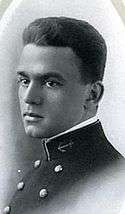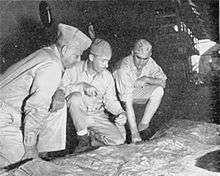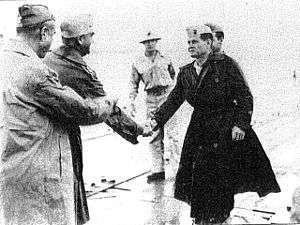Pedro del Valle
| Pedro del Valle | |
|---|---|
|
Lieutenant General Pedro del Valle, USMC the "first Hispanic Marine general" | |
| Born |
August 28, 1893 San Juan, Puerto Rico |
| Died |
April 28, 1978 (aged 84) Annapolis, Maryland |
| Place of burial | United States Naval Academy Cemetery in Annapolis, Maryland. |
| Allegiance |
|
| Service/branch |
|
| Years of service | 1915–1948 |
| Rank |
Lieutenant General |
| Commands held |
|
| Battles/wars | |
| Awards |
Navy Distinguished Service Medal Legion of Merit (2) |
Lieutenant General Pedro Augusto del Valle (August 28, 1893 – April 28, 1978) was a United States Marine Corps officer who became the first Hispanic to reach the rank of lieutenant general. His military career included service in World War I, Haiti and Nicaragua during the Banana Wars of the 1920s, and in World War II, the Battle of Guadalcanal and Battle of Okinawa (Commanding General of the 1st Marine Division).
Early years
Del Valle was born on August 28, 1893 in San Juan, Puerto Rico when the island was still under Spanish colonial rule. He was related to Dr. Francisco del Valle, a surgeon who had served as mayor of San Juan from 1907 to 1910. In 1900, two years after the Spanish–American War, the del Valle family moved to Maryland where they became U.S. citizens (The Jones Act of 1917 later gave United States Citizenship to all Puerto Ricans born on the island).[1] He received his primary and secondary education in Maryland.
On June 17, 1911, after he graduated from high school, del Valle received an appointment by George Radcliffe Colton, who served from 1909 to 1913 as the U.S. appointed governor of Puerto Rico, to attend the U.S. Naval Academy in Annapolis, Maryland. Del Valle graduated from the academy in June 1915 and was commissioned a second lieutenant of the Marine Corps on June 5, 1915.[1][2][3]
Military career
The Banana Wars & pre-World War II

Pedro del Valle helped the Marine Corps in the capture of Santo Domingo, Dominican Republic, in 1916, for which he was awarded his first Legion of Merit. Del Valle commanded the Marine detachment on board the USS Texas (BB-35) in the North Atlantic during World War I. In 1919, he participated in the surrender of the German High Seas Fleet.[1] Later he served as "Aide-de-camp" to Major General Joseph Henry Pendleton after serving on a tour of sea duty aboard the USS Wyoming (BB-32). His job included an inspection tour of the West Indies in the company of General Pendleton.[1]
In 1926, del Valle served with the Gendarmerie of Haiti for three years and, during that time, he also became active in the war against Augusto César Sandino in Nicaragua. In 1929, he returned to the United States and attended the Field Officers Course at the Marine Corps School in MCB Quantico, Virginia.[1]
In 1931, Brigadier General Randolph C. Berkeley appointed del Valle to the "Landing Operations Text Board" in Quantico, the first organizational step taken by the Marines to develop a working doctrine for amphibious assault. In 1932, he wrote an essay titled "Ship-to-Shore in Amphibious Operations" which was published in the Marine Corps Gazette. In his essay, he stressed the importance of a coordinated amphibious assault and of an execution of an opposed landing.[4]
He worked as an intelligence officer in Havana, Cuba in 1933 under Admiral Charles Freeman, following the Cuban Sergeant's Revolt. From 1935–1937, del Valle was Assistant Naval Attache, attached to the American Embassy to Italy in Rome.[1] While on duty, del Valle participated as an observer with the Italian Forces during the Second Italo-Abyssinian War. The experiences which del Valle gained as an observer led him to author the book "Roman Eagles Over Ethiopia" where he describes the events leading up to the Italian expedition and the complete movements of combat operations by the Italian Army under Generals De Bono, Badoglio, and Graziani.[5] In 1939, he was ordered to attend the Army War College in Washington, D.C. and after graduating was named Executive Officer of the Division of Plans and Policies, USMC.[1][5]
World War II
On March 1941, del Valle became the commanding officer of the 11th Marine Regiment, (artillery). Upon the outbreak of World War II, del Valle led his regiment and participated in the Guadalcanal Campaign, providing artillery support for the 1st Marine Division. In the Battle of the Tenaru, the firepower provided by del Valle's artillery units killed many assaulting Japanese soldiers before they ever reached the Marine positions. The attackers were killed almost to the last man.[4] The outcome of the battle was so stunning that the Japanese commander, Colonel Kiyonao Ichiki, committed seppuku shortly afterwards.[6] Major General Alexander Vandegrift, impressed with del Valle's leadership recommended his promotion and on October 1, 1942, del Valle became a brigadier general. Vandegrift retained del Valle as head of the 11th Marines, the only time that the regiment has ever had a general as their commanding officer.[4] In 1943, he served as Commander of Marine Forces overseeing Guadalcanal, Tulagi, and the Russell and Florida Islands.

On April 1, 1944, del Valle, as Commanding General of the Third Corps Artillery, III Marine Amphibious Corps, took part in the Battle of Guam and was awarded a gold star in lieu of a second Legion of Merit. The men under his command did such a good job with their heavy artillery that no one man could be singled out for commendation. Instead, each man was given a letter of commendation by del Valle which was carried in their record books.[7]
In late October 1944, he succeeded Major General William H. Rupertus as Commanding General of the 1st Marine Division, being personally greeted in his new command by Colonel Lewis Burwell "Chesty" Puller. At the time, the 1st Marine Division was training on the island of Pavuvu for the invasion of Okinawa. He subsequently led the division throughout the campaign.[8] Del Valle was awarded a Distinguished Service Medal for his leadership during the battle and the subsequent occupation and reorganization of Okinawa.[4] [9]
Post-World War II
After World War II ended, del Valle was ordered back to Headquarters Marine Corps, where he was named Inspector General, a position which he held until he retired on January 1, 1948. On February 19, 1946 New Mexico Senator Dennis Chavez and del Valle held a meeting with President Harry S. Truman in the White House, in which Chavez recommended del Valle for the position of governor of Puerto Rico.[10] From 1898 to 1942, the governors of the island were officials appointed by the President of the United States. Local Puerto Rican politicians, such as Luis Muñoz Marín, opposed the naming of del Valle in favor of Jesús T. Piñero; to which Del Valle eventually asked President Truman to withdraw his name among those considered for the position. The first civilian and native Puerto Rican appointed governor of Puerto Rico thus became Piñero in 1946. If Congress had not approved legislation in 1947 allowing Puerto Ricans to elect their own Governor, del Valle may have been appointed to the governorship.[11]
Later years
After retiring from the Marine Corps, del Valle worked as a representative of ITT in the company's office in Cairo, Egypt. After some time with the company he was named president of ITT for all South America in Buenos Aires, Argentina, a position that he held until 1951.
Believing that the United States was in danger of a communist threat, del Valle tried to convince the Central Intelligence Agency and Department of Defense to form a vigilante minuteman group. He also believed that the CIA should operate behind Russian and Chinese lines. After his ideas were turned down, he decided to form his own group. In 1953, del Valle met with LtCol John H. Hoffman, LtCol Eugene Cowles Poneroy, Brigadier General Bonner Fellers, and Major General Claire Chennault (USAF) to form the "Defenders of the American Constitution" (DAC). DAC's main goal was to purge the United States of any communist influence. The idea behind the group was to organize the citizens in each state as vigilantes against sabotage and other forms of treason, then link them up in some national headquarters.[12] Del Valle ran for governor of Maryland in 1953 and was defeated in his attempt to be nominated in the Republican primary election. The controversial views shared by some of the members of "DAC" was to blame for the organization's decline in popularity.[12] On April 12, 1961, del Valle invoked The Protocols of the Elders of Zion (an antisemitic hoax) during a speech before the United States Daughters of 1812, in an attempt to "prove" that Communism and Socialism were introduced to Russia by an "Invisible Government" whose intention was to destroy that country. Del Valle also belonged to a group known as the Sons of Liberty, established in 1967 in Annapolis, Maryland and named after the secret patriotic society which directed the actions of the Boston Tea Party on December 13, 1773.[13]
Lieutenant General Pedro del Valle was married to Katharine Nelson (1890–1983). He died on April 28, 1978 in Annapolis, Maryland and was buried in the United States Naval Academy Cemetery and Columbarium. After del Valle’s death at age 85, the DAC ceased to exist.[14]
Written Works by Pedro del Valle
- Books
- Diary and reports of the U.S. naval observer of Italian Operations in East Africa: March 1937 (Washington: Government Printing Office, 1937).
- Roman Eagles Over Ethiopia (Harrisburg, PA: Military service Pub. Co., 1940).
- Semper fidelis: An autobiography (Hawthorne, CA: Christian Book Club of America, 1976).
- Lieutenant General Pedro A. del Valle, U.S. Marine Corps (retired) (Oral history program).
- Articles
- "Guam, the Classical Amphibious Operation" Military Review (1944).
- "Massed Fires on Guam" Marine Corps Gazette(1944).
Military awards
Lieutenant General Pedro del Valle's decorations and awards include:
| Navy Distinguished Service Medal | Legion of Merit w/ one 5⁄16" Gold Star | Navy and Marine Corps Medal | |||||||||
| Navy Presidential Unit Citation w/ one 3⁄16" bronze star | Marine Corps Expeditionary Medal w/ one 3⁄16" bronze star | Dominican Campaign Medal | World War I Victory Medal w/ one 3⁄16" bronze star | ||||||||
| Haitian Campaign Medal (1921) | Nicaraguan Campaign Medal (1933) | American Defense Service Medal | American Campaign Medal | ||||||||
| Asiatic-Pacific Campaign Medal w/ one 3⁄16" silver star | World War II Victory Medal | Order of the Crown of Italy | Italian East African Medal | ||||||||
| Colonial Order of the Star of Italy | Italian Bronze Medal of Military Valor | Order of Naval Merit (Cuba), 2nd class | Ecuadorian Order of Abdon Calderón, 1st class w/ Diploma | ||||||||
See also
- List of Puerto Ricans
- List of Puerto Rican military personnel
- Puerto Ricans in World War I
- Puerto Ricans in World War II
- List of historically notable United States Marines
- Hispanics in the United States Marine Corps
- Hispanics in the United States Naval Academy
References
- 1 2 3 4 5 6 7 "Lieutenant General Pedro A. Del Valle, USMC". Who's Who in Marine Corps History. History Division, United States Marine Corps. Retrieved 2007-10-17.
- ↑ Renda, Mary (2000). Taking Haiti: Military Occupation and the Culture of U.S. Imperialism, 1915-1940. University of North Carolina Press. p. 61. ISBN 978-0-8078-4938-5. Retrieved 2007-10-17.
- ↑ Berry, Henry (1982). Semper Fi, MAC. Quill, William Morrow, New York. p. 42.
- 1 2 3 4 Alexander, Col. Joseph H., USMC (1966). ""Senior Marine Commanders"". The Final Campaign: Marines in the Victory on Okinawa. Quantico, Virginia: Marines in World War II Commemorative Series, History Division, United States Marine.
- 1 2 "Marine Corps History Bookstore". Retrieved 2007-10-17.
- ↑ Frank, Guadalcanal, p. 156-158 & 681 and Smith, Bloody Ridge, p. 43.
- ↑ Emmet, Brief History of the 11th Marines.
- ↑ THE FINAL CAMPAIGN: Marines in the Victory on Okinawa. Retrieved on 2007-10-17.
- ↑ Jesús T. Piñero
- ↑ "Truman's calendar: February 19, 1946". The President's Day. Independence, Missouri: Truman Presidential Museum & Library. 2006. Retrieved 2007-10-17.
- ↑ "Jesus T. Piñero". Hispanic Americans in Congress, 1822-1995. Library of Congress. January 12, 1997. Retrieved 2007-10-17.
- 1 2 "Defenders of the American Constitution". Archived from the original on August 23, 2006. Retrieved 2007-10-17.
- ↑ "Genesis of The Nationalist Movement". Archived from the original on 2007-07-14. Retrieved 2006-06-20.
- ↑ "Cemetery Inventory Form: Del Valle, Pedor A. & Katharine Nelson" (PDF). USNA Cemetery Documentation Project. United States Naval Academy Cemetery of Columbarium. Summer 2005. Retrieved 2007-10-17.
External links
| Wikimedia Commons has media related to Pedro A. del Valle. |
- "Lieutenant General Pedro A. Del Valle, USMC". Who's Who in Marine Corps History. History Division, United States Marine Corps. Retrieved 2007-10-01.
- Alexander, Colonel Joseph H., USMC (Ret) (1996). "Senior Marine Commanders". The Final Campaign: Marines in the Victory on Okinawa. Marines in World War II Commemorative Series, United States Marine Corps. Archived from the original on 2006-05-12. Retrieved 2006-06-14.
- Coogan, Kevin. "Defenders of the American Constitution and the League of Empire Loyalists: The First Postwar Anglo-American Revolts Against the "One World Order"". Archived from the original on August 23, 2006. Retrieved 2006-06-20.
- Emmet, 2ndLt Robert, USMCR (1968). A Brief History of the 11th Marines. Historical Branch, Headquarters Marine Corps, United States Marine Corps. Retrieved 2006-06-14.
- Renda, Mary A. (2000). Taking Haiti: Military Occupation and the Culture of U.S. Imperialism, 1915-1940. University of North Carolina Press. p. 61. ISBN 978-0-8078-6218-6.
- "About Roman Eagles over Ethiopia by Colonel Pedro del Valle, USMC". Marine Corps History Bookstore. Retrieved 2007-10-16.
| Military offices | ||
|---|---|---|
| Preceded by William H. Rupertus |
Commanding General of the 1st Marine Division 2 November 1944 – 8 August 1945 |
Succeeded by Dewitt Peck |


